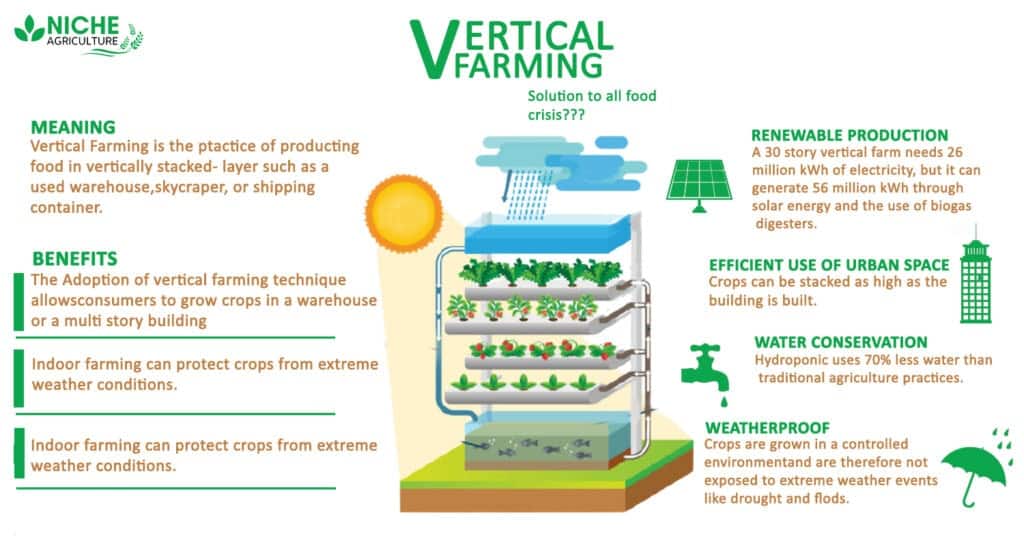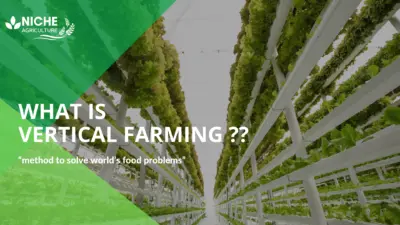Vertical Farming
“Vertical Farming top manta is one crop at a time solving all the world’s food problem at a time.”
Vertical farming relies on the basis to practice the growth of crops in vertically stacked layers. It assimilates in very controlled environment agriculture which aims at optimizing the plant growth and having other soilless techniques like aeroponics, hydroponics, etc.
With many revolutionary vertical farming methods, it is now a day possible to have production of large and persistent and good quality and quantities of food.
But the question arises are there enough pros of vertical farming to make it a scope for further modern agriculture?
Niche Agriculture Ltd
Niche Agriculture is a renowned, successful residential and commercial project that expanded throughout India. In the field of horticulture, vertical farming, and developing innovative solutions, the Niche Agriculture team has taken extensive research and development throughout India to keep the productivity high and the costs low.
Much appreciation to the world-class administration and cutting edge methods, the Niche Agriculture presently has thousands of acres of land ranches, orchards, and plantations beneath its administration.

Pros of Vertical Farming
- Year-round crop production
The greatest vertical cultivating advantage is the truth that it is not subordinate to the climate – meaning you’ll accomplish a reliable year with round crop generation without stressing about the brunt and effect of unfavorable climate conditions. We can have both have quality and profiling of generation and yield with methods of vertical farming. Without compromising the aroma and flavor, you can yield a higher volume of the crop with less harvest time.
- Better utilization of Space
It goes without saying that conventional ranches require rich arable land. But vertical farming can be done and built-in any climate or area – independent of climate conditions or temperature extremes. And since their stacking grows systems permit them to extend upwards, it’s moreover conceivable to attain higher efficiency in a little arable area. Depending on which, one acre of vertical farms is capable of growing crops that are equivalent between 10 or 20 soil-bases acres.
- Water Usage is Minimal
The Hydroponic process of growing in vertical farming uses only a 10% amount of water and very minimal fertilizers and nutrients as compared to the traditional methods of agriculture. It also permits recycling and reusing the water, thus curtailing the cost and minimizing the waste.
Cons of Vertical Farming
- Economic Viability
Constructing Vertical Farms is expensive and extravagant in cities, therefore this will lead to an increase in total investment and operating costs. Moreover, the approval of constructing the vertical farms’ can increase the cost of occupation due to added needs. Moreover, this is one of the major drawbacks as the pollination of seeds has to be done manually therefore, the wages paid are high.
- Environment and energy impacts
Concerns about contamination and economic utilize emerge since home-grown crops depend on artificial light. There are numerous vertical planting ranches utilizing 1000-watt LED grow lights. In expansion to these artificial lighting, vertical farms have complex apparatus and computerized frameworks. Subsequently, vertical cultivating requires more vitality input compared to field farming. Since vertical cultivating depends on the utilize of fossil fuels, this hone has indeed more noteworthy impacts. There is a requirement need to create renewable and elective vitality innovations to guarantee the natural sustainability and vitality effectiveness of vertical farming.
- The artificial environment can fail at any point
Completely relying on vertical technology can be a major disadvantage of vertical farming. It can be a great loss in production if vertical farms lose energy per day. This impacts that vertical farming will be wholly dependent on an artificial atmosphere that maintains a temperature of 40 degrees C and constant humidity and the crops grown by vertical farms can die from energy shortages.
Conclusion
Healthy or sick? Which one will you choose?
So, yes Urban Vertical Farming is one of the greatest and fastest-growing trends in food production. Vertical farms have the potential to reach $1.97 billion people by 2020, though it includes sales of LED lights and hydroponic pieces, it still speaks insatiable growth of the industry.
By 2050, there will be 3 billion more individuals in presence, and about 80% of the world’s populace will live in urban regions. The demand for bizarre nourishment will be exceptional, and we are going ought to figure out how to urge nourishment to the cities within the most successful way. Enter vertical farming
– the thought of building whole skyscrapers possessed with vertically-stacked ranches that create crops twice as quick, whereas utilizing 40% less power, having 80% less food squander, and utilizing 99% less water than outdoor fields. Is it doable, or is it a futuristic cash pit?

